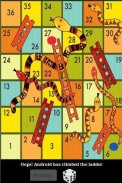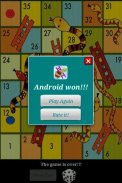






Snakes and Ladders

Snakes and Ladders介绍
Snakes and Ladders originated in India as part of a family of dice board games, including pachisi (present-day Ludo). It was known as moksha pAtam or vaikunthapaali or paramapada sopaanam. The game made its way to England and was sold as Snakes and Ladders, then the basic concept was introduced in the United States as Chutes and Ladders.
Each player starts with a token on the starting square (usually the "1" grid square in the bottom left corner, or simply, the imaginary space beside the "1" grid square) and takes turns to roll a single die to move the token by the number of squares indicated by the die roll. Tokens follow a fixed route marked on the gameboard which usually follows a boustrophedon (ox-plow) track from the bottom to the top of the playing area, passing once through every square. If, on completion of a move, a player's token lands on the lower-numbered end of a "ladder", the player moves his token up to the ladder's higher-numbered square. If he lands on the higher-numbered square of a "snake" (or chute), he must move his token down to the snake's lower-numbered square. If a player rolls a 6, he may, after moving, immediately take another turn; otherwise play passes to the next player in turn. The player who is first to bring his token to the last square of the track is the winner.
Features:
1. Free play
2. 6 by 6 grid
3. Human vs Android
4. Human Vs Human
蛇和梯子起源于印度作为一个家庭的骰子棋盘游戏,包括棋(今鲁)的一部分。它被称为解脱pAtam或vaikunthapaali或paramapada sopaanam。游戏的方式作出了英格兰和销售作为蛇和梯子的话,基本概念是在美国的爬坡与梯子介绍。
每个玩家开始在起点方令牌(通常是“1”方格中的左下角,或者简单地说,“1”方格旁的想象空间),并轮流推出单芯片移动令牌由模具辊所示的正方形的数目。令牌遵守标上通常遵循boustrophedon(牛犁)的轨道,从底部到播放区域的顶部,通过每平方过一次GAMEBOARD固定路线。如果,一动完成时,在一个“阶梯”低编号的末尾玩家的令牌土地,玩家将他的道理了梯子的编号较高的广场。如果他的土地上的“蛇”(或槽)的编号较高的广场上,他必须将自己的令牌倒在蛇的低编号的正方形。如果玩家掷出6,他可以移动后,立即采取另一种转;否则玩通行证又将下一个玩家。这名球员是谁第一个把自己的令牌轨道的最后方是赢家。
产品特点:
1,免费打
2 6 6格
3,人类与机器人
4,人类VS人类

























